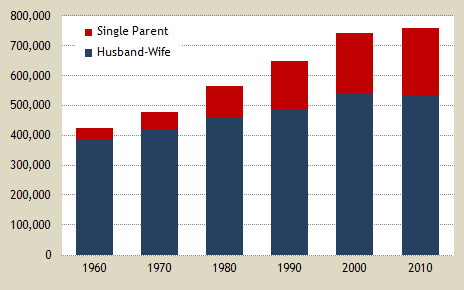 There is a lot of logos present in
this article in order to set the basis of the argument, which is if the Nuclear
Family type of household back in the sixties were more beneficial than the
common currently types of households consisting of single parents, single sex
parents, and single generations. The primary method logos is applied is through
different case studies and their findings.
There is a lot of logos present in
this article in order to set the basis of the argument, which is if the Nuclear
Family type of household back in the sixties were more beneficial than the
common currently types of households consisting of single parents, single sex
parents, and single generations. The primary method logos is applied is through
different case studies and their findings.  The first type of household is
single parenthood, and the author begins by stating 29.5% of American
households were of single family. This is a two percent increase from 2000, and
this article was written in 2013. 84.1% of the single parent households were
also headed by the mother as opposed to the father at 15.9%. A nuclear
household in the sixties had two parents and divorce was not common. Studies
unanimously support traditional two parent households, mainly because of the
financial security. The double parenting in turn leads to higher achievement inschool, lower levels of psychological distress, and later sexual activity. The
logos mentioned for single parenting suggest that the Nuclear Family structured
household was more beneficial to children.
The first type of household is
single parenthood, and the author begins by stating 29.5% of American
households were of single family. This is a two percent increase from 2000, and
this article was written in 2013. 84.1% of the single parent households were
also headed by the mother as opposed to the father at 15.9%. A nuclear
household in the sixties had two parents and divorce was not common. Studies
unanimously support traditional two parent households, mainly because of the
financial security. The double parenting in turn leads to higher achievement inschool, lower levels of psychological distress, and later sexual activity. The
logos mentioned for single parenting suggest that the Nuclear Family structured
household was more beneficial to children.  Most Nuclear Families also had a significant
influence from grandparents. The author mentions one in twenty children in the
United States grow up in a multigenerational household today, and these kinds
of households have “more consistently positive outcomes.” One case study
mentioned is of African American children and grades being higher in
multigenerational families. Another case study from 1996 mentioned is about
healthy habits and that kids are more likely to not smoke and drink if they’re
raised in a home with grandparents. Again, these facts the author mentions propose
the Nuclear Family structure from the sixties was more beneficial to children’s
development.
Most Nuclear Families also had a significant
influence from grandparents. The author mentions one in twenty children in the
United States grow up in a multigenerational household today, and these kinds
of households have “more consistently positive outcomes.” One case study
mentioned is of African American children and grades being higher in
multigenerational families. Another case study from 1996 mentioned is about
healthy habits and that kids are more likely to not smoke and drink if they’re
raised in a home with grandparents. Again, these facts the author mentions propose
the Nuclear Family structure from the sixties was more beneficial to children’s
development.  Homosexual parenting is another
common type of household that is rapidly emerging today that did not exist in
the sixties, as homosexuality was not deemed acceptable. Today however, one to
nine million children has at least one gay parent. The author mentions common
concerns about this type of structure such as the child will grow up sexually
confused, socially inept, or not fully developed. Case studies the author mentions
reveals that same sex parenting has no influence on psychological conditions of
the child like depression or anxiety and does not have any correlation with
drug use and bad behavior. Unlike the other two types of present day
households, the logos the author mentions in this type of structure does not
seem to be negative.
Homosexual parenting is another
common type of household that is rapidly emerging today that did not exist in
the sixties, as homosexuality was not deemed acceptable. Today however, one to
nine million children has at least one gay parent. The author mentions common
concerns about this type of structure such as the child will grow up sexually
confused, socially inept, or not fully developed. Case studies the author mentions
reveals that same sex parenting has no influence on psychological conditions of
the child like depression or anxiety and does not have any correlation with
drug use and bad behavior. Unlike the other two types of present day
households, the logos the author mentions in this type of structure does not
seem to be negative.
The logos the author used was key in presenting the purpose of the article, which was comparing and contrasting different types of households found today and whether or not they are beneficial to the development of children. The statistics stated about single parents and non multigenerational households portrayed them in a bad light whereas the opposite occurred for homosexual households, as they seemed to have no effect on the children. By stating hard facts from case studies, the author maintains a professional and unbiased stance on the topic.
-Priyal Patel
No comments:
Post a Comment